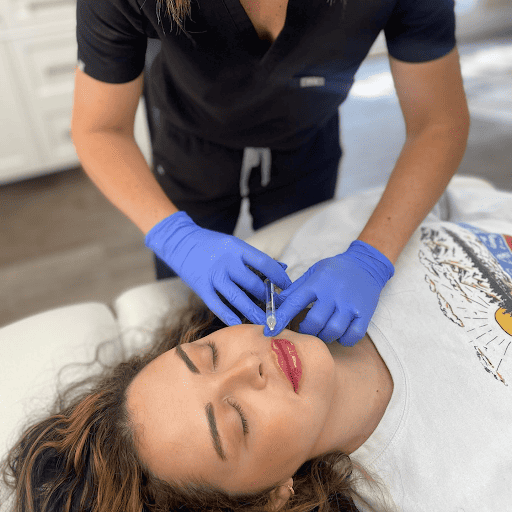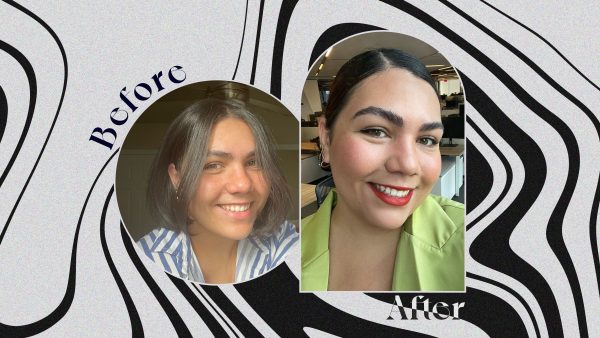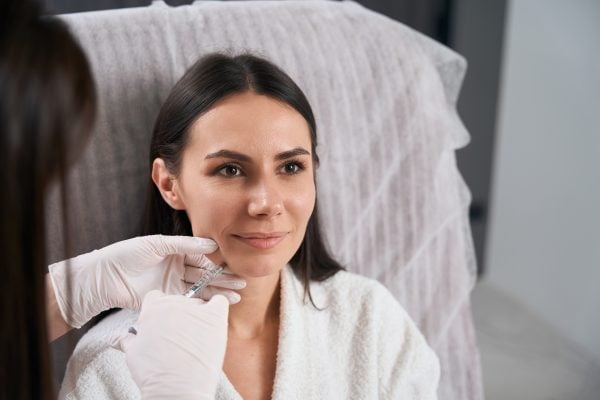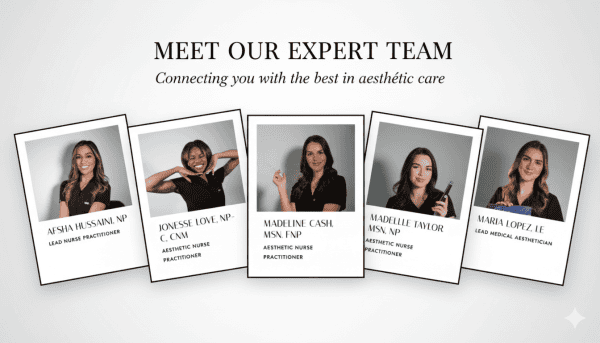Medical aesthetics is a fascinating and potentially daunting field to enter. Chin Up! Aesthetics offers a wide range of aesthetic treatments to enhance your appearance and your confidence. But just as alluring as these procedures can be, they also present potential risks, making safety an essential factor to consider.
In this article, we will explore the intricacies of the safety of medical aesthetics, providing practical tips and insights on potential risks to guide you through a journey that should be as safe as it is transformative.
Let us explore this area where beauty and science meet, with our health as our top priority.
Ensuring the Safety of Patients in Medical Aesthetic Practices
In the field of medical aesthetics, patient safety is paramount. The proper placement of subcutaneous structures (such as ligaments, arteries, veins, nerves, muscles, and injectables like stomach fillers) and aesthetic products requires an in-depth understanding of anatomy, which practitioners must have.
Attending conferences, reading journal articles, and staying up to date on new techniques are all essential for continuous learning and improvement.
Patient consultations also play a significant role in ensuring safety by carefully listening to patients, understanding their priorities and health history, and providing full disclosure about treatment options, associated risks, and benefits.
To ensure patient satisfaction, it is critical to inform them about the treatment’s duration, expected outcomes, potential side effects, and post-treatment instructions.
Keeping high standards of safety and ethics is especially important in practices that are smaller or run by a single practitioner, where there is less capacity for oversight. To determine if new technologies and services truly benefit patients, they must be critically evaluated.
Now that we understand the importance of ensuring safety in medical aesthetics, let’s explore how we can identify established practitioners who prioritize patient well-being.

Finding Experienced & Knowledgeable Practitioners
When it comes to choosing a certified professional for your aesthetic treatments, it’s essential to do your research and identify established professionals who uphold high standards of safety and ethics. Here are a few factors to consider:
1. Qualifications and Credentials: Look for professionals who have proper qualifications and certifications in medical aesthetics. Verify if they have undergone specific training and have experience in the procedures you are considering.
2. Reputation and Reviews: Read reviews and testimonials from previous patients to get an idea of their experiences. Positive feedback from satisfied patients can indicate a level of trustworthiness.
3. Referrals: Seek recommendations from trusted sources like friends, family members, or healthcare professionals who have had successful experiences with aesthetic treatments.
4. Facility Standards: Ensure that they follow appropriate sanitary measures and maintain a clean and well-equipped environment. This demonstrates a commitment to patient safety.
5. Transparent Communication: A reputable practitioner will take the time to listen to your concerns, thoroughly explain procedures and potential risks, and provide clear post-treatment instructions. They will prioritize patient education and informed decision-making.
It’s important to remember that safety in medical aesthetics is a shared responsibility between the patient and the service provider.
By selecting an established professional who prioritizes patient care and maintains open communication throughout the process, you can enhance the likelihood of a positive and safe aesthetic experience.
- A 2017 review published in the Journal of Cutaneous and Aesthetic Surgery found that adverse events related to cosmetic procedures are relatively rare, with an incidence rate ranging from 0.4% to 2.0%, depending on the procedure.
- According to a survey by the International Society of Aesthetic Plastic Surgeons (ISAPS), there was a significant increase of around 7.4% in non-surgical cosmetic procedures worldwide from 2018 to 2019, demonstrating a growing need for patient education and safety awareness.
- The American Society of Plastic Surgeons reported that out of all aesthetic procedures performed in their study period, non-invasive treatments accounted for nearly 85%, highlighting the trend towards safer, lower-risk options within the industry.
Important Questions for the Consultation
Before embarking on any aesthetic procedure, it is essential to have a comprehensive consultation with your provider. This initial consultation serves as an opportunity to gather crucial information and clarify any doubts or concerns you may have.
This is especially important when considering injectable treatments. Here are some important consultation questions to ask:
1. Potential Results and Limitations: Ask about the expected outcomes of the procedure, including any potential limitations or risks involved. It is important to have realistic expectations and a clear understanding of what can be realistically achieved, whether you’re receiving Botox or any other kind of procedure.
2. Procedure Information: Request a detailed explanation of the procedure itself, including its duration, anesthesia options, recovery time, and any special aftercare instructions. If you’re considering Botox, for example, ask the medical team about the procedure and aftercare. Understanding these aspects will help you prepare and make informed decisions.
3. Potential Complications: Discuss any potential complications or side effects associated with the procedure. It is important to be aware of potential risks so that you can make an informed decision, whether you are getting botox or another procedure.
4. Alternatives and Potential Treatments: Look for alternative treatments or procedures that may be suitable for your goals and concerns. A reputable provider will provide you with different options and explain which may be the best fit for you.
Remember that consultations are an excellent opportunity for open communication with the service provider. During this meeting, you should share your medical history, allergies, medications, and previous procedures to ensure a thorough evaluation before proceeding with any procedure.
Potential Risks and Dangers in Aesthetic Procedures
While medical aesthetic procedures continue to evolve and offer exciting possibilities for enhancing our appearance, it is crucial to be aware of the potential risks and dangers associated with these treatments.
The following are some common considerations when it comes to aesthetic procedures:
- Infection: Any medical procedure involving incisions or injections carries a risk of infection. It is essential to choose a reputable clinic or medical spa with a certified team adhering to strict hygiene protocols and following post-procedure care instructions to minimize this risk.
- Allergic Reactions: Certain individuals may be susceptible to allergic reactions from substances used in aesthetic procedures. Inform your provider about any known allergies before undergoing treatment.
- Pain and Discomfort: Most aesthetic procedures involve some degree of pain or discomfort during or after the procedure. Discuss anesthesia options and pain management techniques to ensure you are comfortable throughout the process.
- Bruising and Swelling: Bruising and swelling are common side effects following many aesthetic treatments, but they typically subside within a few days or weeks. Excessive bruising or prolonged swelling, on the other hand, should be reported.
- Misaligned Expectations: Unrealistic expectations can lead to disappointment or dissatisfaction with results. It is critical to have open and honest conversations with your provider about what the chosen procedure can realistically achieve.
Keep in mind that these risks and dangers change from procedure to procedure, patient to patient, and provider to provider’s and team’s level of expertise. To minimize the risks associated with aesthetic procedures, it is vital to choose a skilled and experienced practitioner.
Dangers of Untested Procedures
Some people may be tempted to try out cutting-edge medical aesthetic treatments in their quest for a more youthful appearance. However, it is crucial to recognize the dangers associated with untested procedures.
Insufficient testing and clinical trials have been carried out to establish the safety and efficacy of these treatments, despite their potentially revolutionary effects. Going through these procedures without proper research and evidence could endanger your health, which is why it is best to choose better-researched procedures.
Nonetheless, side effects, infections, scarring, or even long-term problems are all possibilities that cannot be eliminated without thorough testing. A safer alternative would be treatments like Botox, which has undergone extensive testing and evaluation.
Keep in mind that you should put patient safety first and proceed with caution when attempting a brand-new aesthetic procedure. By choosing a well-established medical spa or clinic that has undergone thorough testing, you can significantly reduce the risks associated with untested procedures.
Adverse Reactions: Recognizing Symptoms
While the goal of medical aesthetic procedures is to improve one’s look and self-esteem, it is important to be mindful of the possibility of side effects that may develop after these procedures. Recognizing symptoms is critical for ensuring timely intervention and appropriate management.
Some common adverse reactions include redness, swelling, bruising, or temporary discomfort in the area of treatment. These reactions are generally mild and subside within a short period. However, more severe reactions may indicate an underlying problem that requires attention.
Additionally, seek immediate medical attention if you experience any of the following symptoms: extreme pain, persistent swelling or bruising, intense itching or rash, blistering, or skin discoloration.
Inadequate treatment or delayed recognition can worsen the condition and cause more complications.
It is important to keep in mind that everyone reacts differently to medical aesthetic treatments; what one person considers a normal reaction might look very different to another. As a result, to ensure your safety and optimal results, you must follow your healthcare provider’s post-treatment instructions and promptly report any unexpected symptoms or concerns.
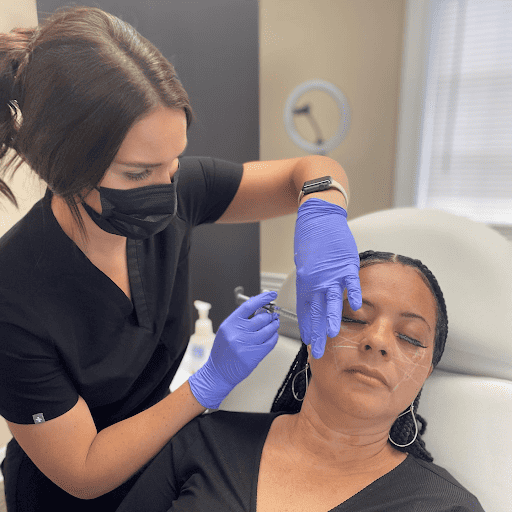
Methods to Mitigate Risks
When it comes to receiving medical aesthetic procedures, the safety of the patient should always be the top priority. While complications are possible, implementing proactive measures to mitigate risks is essential.
Here are some best practice recommendations:
Firstly, it is essential to choose a qualified and experienced medical professional to administer your aesthetic treatments. Carefully research their credentials, training, and reputation before making a decision.
A skilled practitioner can provide expert guidance, easing your concerns and minimizing the potential for complications.
Effective communication between the patient and the medical professional is critical in the field of medical aesthetics to ensure safe treatment outcomes. Be honest about your medical history, current medications, allergies, and procedure expectations to help the practitioner tailor the best treatment plan for you, taking into account risks and contraindications.
Thoroughly researching the specific procedure you are considering undergoing is another effective approach. Make sure you are well informed about the treatment’s advantages, disadvantages, risks, anticipated results, recovery time, and aftercare.
At Chin Up! Aesthetics, we take the time to explain the process and any potential side effects of each of our aesthetic treatments.
This comprehensive understanding will enable you to make an informed decision and set realistic expectations for the procedure.
Additional factors contributing to risk reduction include adequate pre-and post-operative care. Pay close attention to all pre-procedure instructions given to you by your healthcare provider. Follow all post-operative care instructions.
This includes attending to any wounds that may have occurred and avoiding anything that could impede healing or lead to complications.
Regular follow-up visits are also an important part of your treatment plan. These visits are critical for assessing progress, responding quickly to concerns, and intervening early if complications arise. Prompt intervention can prevent complications from worsening or becoming long-term issues.
By vigilantly implementing these protective strategies, you can significantly reduce the risks associated with medical aesthetic treatments, ensuring a safer and more satisfactory overall experience.
Now that we have discussed how to mitigate risks connected with medical aesthetic procedures, let’s explore how to recognize and avoid unsafe treatment practices to further protect ourselves as patients.
Recognizing Unsafe Treatment Practices
When seeking medical aesthetic treatments, the ability to identify signs of unsafe practices is critical. One significant indication of an unsafe treatment facility is a lack of proper cleanliness and hygiene protocols.
The clinic or spa must adhere to strict infection control measures, including the use of sterile equipment, disposable needles, and high-standard sanitization practices.
If you come across inflated prices or offers that look too good to be true, you should be wary. Quality treatments necessitate skilled expertise, high-quality products, and cutting-edge technology, all of which are costly.
When prices are suspiciously low, it may be an indication that safety standards have been compromised or that counterfeit or substandard products are being used.
Another warning sign is a lack of transparency or reluctance to provide thorough information about the procedure, potential risks, or recovery process. A reputable medical professional should be able to address all your questions and concerns openly and honestly.
Embrace Your Beauty & Confidence With Chin Up! Aesthetics’
When it comes to improving our appearance, safety comes first. To give you an experience that is based on safety and trust, our commitment to your well-being extends beyond mere aesthetics.
At Chin Up! Aesthetics, we meticulously uphold the highest safety standards of medical aesthetics.
Our certified team of expert injectors, armed with cutting-edge techniques, navigates the nuanced landscape of beauty procedures with precision and expertise.
Furthermore, we take a comprehensive approach to medical aesthetic safety, combining cutting-edge technology to ensure that every procedure boosts confidence as well as enhances beauty.
For more information on medical aesthetic treatments and to request a free consultation, please visit us online or give us a call!

